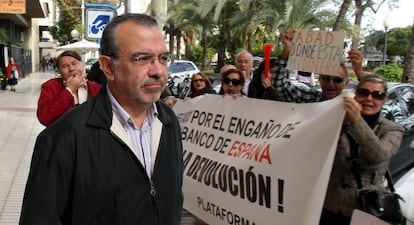Failed lender CAM wants prison for two of its former executives
Bank's lawyer seeks six to 10 years for ex-director general and oversight committee chief Attorney accuses them of inflating expense accounts and favoring own interests

The lawyer of failed lender Caja de Ahorros del Mediterráneo (CAM), appointed by the government’s bank bailout fund, the FROB, wants prison terms for two of the bank's former top executives.
Former director general Roberto López Abad and former chairman of the Valencian savings bank’s oversight committee, Juan Ramón Avilés, face the prospect of between six and 10 years in prison for misappropriation of funds and deliberate mismanagement.
The state prosecutor is seeking shorter jail terms for the two men.
The High Court investigation into the sacking of CAM, which a Bank of Spain governor described as “the worst among the worst” because of its spectacular mismanagement, points at Abad and Avilés as the masterminds behind a careful plan to take as much money as possible out of the foundering lender. The bank went from posting profits of 244 million euros in 2010 to losses of 2.7 billion the next year.
Abad made as much as 308,700 euros between 2007 and 2011 just by claiming expenses
Both are believed to have used their privileged positions to wildly inflate their own expense accounts and favor their private real estate interests. The lawyer for CAM charges that, not content with receiving allowances for sitting on the oversight committee, Abad and Avilés created a second identical committee that effectively multiplied their allowance by 10. Abad made as much as 308,700 euros between 2007 and 2011 just by claiming expenses.
CAM also states that both men benefited from transactions that were ruinous to the lender. In June 2011, when CAM was bailed out with a 5.2-billion-euro liquidity injection, the savings bank had lost 416 million euros out of a 575-million investment in hotel and real estate projects in which Abad had a personal involvement.
In January 2008, CAM also financed another ruinous operation that benefited Avilés. The savings bank approved two loans worth 16.2 million euros to La Vereda de Sucina, a company owned by Avilés, to build a residential estate with 174 homes in Sucina in Murcia. The houses did not sell well, yet CAM refinanced the project with even higher loans that were never put to the board for approval. This occurred just three months before the bailout, when it was already evident that the lender was close to bankruptcy.
The events described by the CAM lawyer are only a fraction of the sacking that went on at CAM for years, by these and other executives. Examining Judge Javier Gómez Bermúdez is also investigating loans worth 160 million euros to purchase hotels and land in Mexico, Dominican Republic and Costa Rica through a company headquartered in the tax haven of Curaçao. The tax fraud could be as much as 31.8 million euros.
CAM, which was sold to Banco Sabadell for one euro in December 2011, has come to symbolize the worst of the excesses by Spain’s regional savings banks, which invested heavily in the property market and were forced to merge with each other to avoid bankruptcy when the real estate bubble burst in 2008.
Tu suscripción se está usando en otro dispositivo
¿Quieres añadir otro usuario a tu suscripción?
Si continúas leyendo en este dispositivo, no se podrá leer en el otro.
FlechaTu suscripción se está usando en otro dispositivo y solo puedes acceder a EL PAÍS desde un dispositivo a la vez.
Si quieres compartir tu cuenta, cambia tu suscripción a la modalidad Premium, así podrás añadir otro usuario. Cada uno accederá con su propia cuenta de email, lo que os permitirá personalizar vuestra experiencia en EL PAÍS.
¿Tienes una suscripción de empresa? Accede aquí para contratar más cuentas.
En el caso de no saber quién está usando tu cuenta, te recomendamos cambiar tu contraseña aquí.
Si decides continuar compartiendo tu cuenta, este mensaje se mostrará en tu dispositivo y en el de la otra persona que está usando tu cuenta de forma indefinida, afectando a tu experiencia de lectura. Puedes consultar aquí los términos y condiciones de la suscripción digital.
Últimas noticias
Most viewed
- Pablo Escobar’s hippos: A serious environmental problem, 40 years on
- Why we lost the habit of sleeping in two segments and how that changed our sense of time
- Charles Dubouloz, mountaineering star, retires at 36 with a farewell tour inspired by Walter Bonatti
- Reinhard Genzel, Nobel laureate in physics: ‘One-minute videos will never give you the truth’
- The Florida Keys tourist paradise is besieged by immigration agents: ‘We’ve never seen anything like this’








































